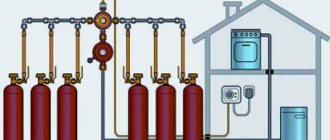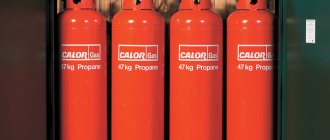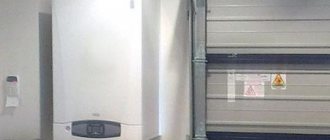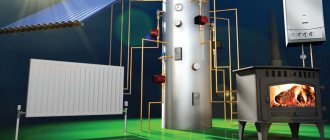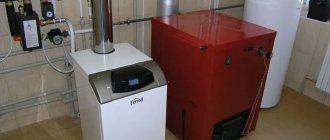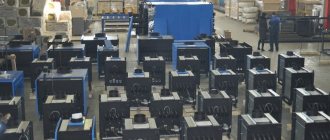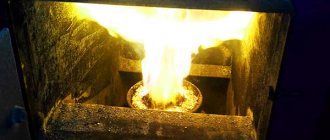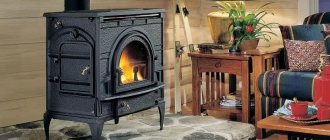To install a heating system, you will need a source of thermal energy. This can be main or liquefied gas, firewood, electricity or liquid fuel. The most profitable option is gas. But not all settlements have mains gas. In this case, use its liquefied version. If you decide to use a gas cylinder for heating, you need to familiarize yourself in advance with the advantages and disadvantages of such systems, as well as understand the nuances of their design.
Bottled gas heating and what is it?
Heating systems that use liquefied gas to heat the coolant are the type we are describing. If methane gas circulates in the central line, then the cylinders are filled with propane or a mixture of butane and propane. Heating with gas cylinders in a private house is done if it is not possible to connect to a centralized gas supply.
Such systems are used in houses with an area of 70-100 square meters. In this case, the building must be well insulated to minimize fuel consumption. Also, to save gas, it is recommended to use not only a boiler running on this fuel, but also electrical heating appliances.
Important! The fuel is in cylinders under high pressure, so disassembling or damaging the containers is prohibited.
Pros and cons of balloon heating
Gas heating from bottled gas has the following advantages:
- The cylinders contain fully purified fuel, which promotes complete combustion in the boiler chamber. As a result, no slag or ash remains.
- Gas-fired heating equipment does not need to be connected to power supply systems, so such heating can be called energy-independent.
- The heating system works stably and smoothly, and its operation is easy to manage.
- Ease of operation is an additional advantage of bottled gas heating.
- The price of gas is the lowest in comparison with other types of fuel.
- The efficiency of such a system is quite high and reaches 90-95%.
- If necessary, heating equipment can be converted to operate on mains gas.
- An impressive service life can also be considered one of the advantages of such heating.
Used cylinders can be sold on the secondary market to offset some of the costs. If you install a double-circuit boiler running on liquefied gas, you can not only heat the house, but also provide it with hot water supply.
The disadvantages of heating with propane or a mixture of propane and butane are the need to regularly refill gas storage tanks. In addition, for the correct and uninterrupted operation of the system, certain conditions must be created.
Gas boiler from a 50 liter cylinder: how long will it last?
Often, owners of country houses, as well as real estate within the city, refuse centralized heating and main gas pipelines in favor of alternative options that provide for the possibility of heating premises using liquefied gas. It is easy to use and more affordable. The radiator and battery heat up no worse.
Modern gas heating of premises using boilers operating on liquefied gas involves the use of a number of parts, consisting of several types of equipment and a heat supply system. Only the main unit in this design still remains the boiler, which is responsible for generating heat.
As with standard heating appliances, a gas boiler that operates on liquefied gas allows private homes to provide room heating, as well as hot water supply, through its combustion. Often this heating equipment is characterized by its compact size, high performance and good efficiency indicators, which sometimes reach 95%.
In addition, such a device has the following advantages:
- Low cost;
- Allows you to significantly reduce the funds spent on heating and hot water;
- Can operate at low gas pressure;
- Has low fuel consumption;
- Allows you to turn off the heating when it is not needed.
If you use a gas boiler that runs on propane, then the fuel consumption will be approximately as follows: 130 sq. m, taking into account high-quality windows and entrance doors, will be in the area of one cylinder, weighing 50 kg for 2 or 3 days. If your desired room temperature is at least 21-23, and in addition to this you also need hot water, then you will have to refill 3 - 4 cylinders per week. If your home is smaller, fuel consumption decreases proportionately.
Connection diagram for gas cylinders to a heating boiler
To connect the cylinder to the boiler, a special reducer is used, which converts liquefied fuel into a gaseous state. It is in this form that it is supplied to the heating equipment. If several containers are used at once, then the same number of reducers will be needed to connect to each cylinder. This is much safer than connecting several containers at once through one common gearbox.
Important! If you use several cylinders, you can increase the operating interval of the equipment on one fuel fill.
To assemble the entire structure, a two-arm collector is used. This is a special ramp that divides all containers into two groups. One group is the main one. From it, gas enters the boiler first. The second group is the reserve group. It is used after the main group runs out of gas. Switching from one group to another occurs automatically. At the same time, a characteristic signal is heard. After refueling and connecting the tanks of the main group, the collector begins to consume fuel from these cylinders.
Gas equipment for home heating - burners for stoves and boilers
All containers with fuel are installed from the boiler at a distance of no closer than 200 cm. It is best to allocate a separate room for these purposes or fence off a compartment in the furnace room. It is prohibited to install cylinders in an uncovered place exposed to sunlight.
To connect containers, metal pipelines with a wall thickness of less than 2 mm are used. In the place where the pipes pass through the walls, protective cases are installed, and all openings are filled with foam. A durite hose is used to connect the pipeline to the heater.
Installation and operation of an LPG tank
Each heating option has its own nuances in matters of design, installation work, commissioning, fuel purchase and further maintenance of the system. For example, to organize heating of a house using electricity and main gas, it is mandatory to obtain specifications from the supply company. Not always and not all electric or gas networks have additional capacity for connection.
Heating a private household with a minigas holder does not require approvals from government agencies or their notification at all, but such equipment has its own mandatory safety requirements.
The installation of a gas holder in a local area should be carried out by a specialized company. You cannot do this on your own. Then it will be extremely difficult to find an LPG supplier, since if problems arise when pumping liquefied gas into the container, he bears responsibility for everything. It’s unlikely that anyone would want to be responsible for someone else’s mistakes in the installation and selection of gas tank fittings.
In terms of ease of coordination, design and execution of installation work, the gas holder is second only to solid fuel boilers. They just need to be delivered to the house and installed in the boiler room.
Selecting a site for a gas tank
One of the most problematic aspects in organizing gas tank heating is the choice of location for an underground LPG tank. Here it is important to take into account fire and technical safety regulations, as well as the characteristics of the soil and the gas equipment itself.
Structurally, gas tanks for autonomous gas supply are:
- vertical;
- horizontal;
- mobile (ground on a trolley).
They also differ in shape into cylindrical and spherical.
For gas supply to cottages, it is recommended to choose horizontal cylindrical gas tanks; they are large in width/length and take up a lot of space, but they are not laid too deep in the ground
Mobile installations for storing LPG in the Russian climate are generally of little use. In the gas holder, the propane-butane mixture is partially liquefied and partially gaseous. Moreover, if propane retains its gas properties down to -35 °C, then butane already at -0.5 °C turns into liquid.
At low outside temperatures, it will be impossible to obtain butane in the required state for combustion in a heating boiler from an above-ground reservoir. To do this, it will have to be heated, which will further increase the cost of heating the house.
In the gaseous state, propane and butane are heavier than air, so gas tanks should not be installed near wells and basements. If there is a leak, gas will begin to accumulate in these depressions and sooner or later will explode
The location for the underground gas tank is selected so that:
- the distance from a residential building to a tank with LPG with a capacity of no more than 10 m3 was at least 10 m;
- the container was located at least 2 m from the buried foundations of buildings;
- there was easy access to the storage tank for refueling from a tanker;
- the tank was buried below the freezing point of the soil;
- there were no buildings, electrical cables, concrete paths, trees, etc. above.
Only lawns are allowed on top of the gas holder. At the same time, you will even have to mow the grass on them the old fashioned way - with a scythe, and not with an electric or gasoline lawn mower. The slightest spark, coupled with gas accumulated due to a small leak, will certainly lead to a fire or pop.
We also recommend reading our other article, where we talked in detail about how to properly place a gas tank on a site.
Checking, refueling and maintenance
The volume of the gas tank is selected so that it has to be refilled a maximum of two or three times a year. In this case, the car does not necessarily have to drive directly to the underground tank to refuel. Most of these tanks for transporting LPG are equipped with hoses 30–40 meters long.
LPG is sold on the market in “summer” and “winter” versions. They differ in the proportions of butane and propane, and also have different heat capacities. At the same time, “winter” gas is more expensive, but “summer” gas cannot be used in cold weather.
If you install a large, capacious gas tank for one annual refueling, you can save money by buying a cheaper version of LPG. But there is a risk of being left completely without fuel in winter due to the inability of the propane-butane mixture to transform into a gaseous state for supply to the heating boiler.
With proper installation, proper supervision and filling with high-quality gas mixtures, the gas holder can serve properly for 20–30 years, then the container will have to be replaced
After installation is completed, the owner of the house must monitor the condition of the gas tank. Typically, the maintenance and repair of this equipment is carried out by the LPG supplier, for which a corresponding agreement is concluded.
Rostechnadzor specialists do not inspect private gas tanks intended for heating cottages and dachas with gas. This is not their profile at all. Inspections can only come from the Ministry of Emergency Situations; firefighters will constantly check fire-hazardous objects and boiler equipment for preventive purposes.
Components for cylinder heating systems
Heating using liquefied gas is done using the following components:
- heating equipment with a gas burner;
- reducers for connecting cylinders;
- fuel containers with a capacity of 50 liters;
- ramp;
- rubber-fabric sleeve for connecting the pipeline to the boiler;
- shut-off valves.
The connection diagram is very simple, so it can be implemented by hand. When choosing a suitable gas boiler, give preference to units operating at minimum pressure and maximum efficiency. Consider what type of fuel the boiler is designed for. There are units that run only on liquefied gas. But if in the future you plan to connect the main gas supply, then it is better to prefer universal models that can operate on different types of fuel.
The gas boiler burner must have narrow nozzles that are designed to operate under high pressure bottled gas conditions. Units designed to use mains gas have wide nozzles. If liquefied fuel is supplied through such devices, an accident may occur.
Boilers designed to operate on LPG (liquefied petroleum gas) have special nozzles and a gas valve. To independently convert a conventional boiler to operate using liquefied fuel, you will need to purchase the necessary parts.
Heating from a gas cylinder (video)
Owners of private homes should be aware that heating boilers run on liquefied gas. It is possible to switch to a different operating mode without any problems, and they will work using a different type of fuel, or rather main gas. To do this, you just need to replace the burner, nozzles, remove the gearbox and replace some other equipment. You can do all this with your own hands, however, in order to properly install the connection, you must follow the rules for using propane installations.
Good day everyone! Due to popular demand, I decided to create a blog about my heating of a country house! IF SOMETHING IS WRONG OR THE OWNERS OF THIS SYSTEM DO NOT AGREE, PLEASE DO NOT BE OFFENSED! Since there is no centralized gas, but there is imported gas in cylinders. I am very glad! Everyone knows very well about the situation of electric heating in the country, it really hits the pocket. Well, maybe not for everyone, but still. Well, I thought for a long time, talked to people and came to the conclusion to install gas heating for myself. But then the question arose of what to install for myself and how it would behave (either a gas Boiler or a gas Convector) As a result, I settled on GAS CONVECTORS. Yes, every convector there is a pipe that goes out to the street through the wall, that’s why they hang on the wall. WHY? Firstly, and this is the most important thing, GAS CONSUMPTION (Gas convector consumes from 0.200 to 0.250 grams per hour) While (GAS BOILER consumes approximately and this is at least 1.3 liters per hour) I want to dispel the strange thoughts that sometimes pop into my head , Below in the photo they are hanging on the wall Gas convector pipes go out onto the street (for air intake and burnt gases out) So Gentlemen, if anyone doesn’t know, GAS CONVECTOR WORKS THE JUST LIKE A BOILER, it has 7 operating modes knob from 1 to 7 (That is it turns on and off when a certain temperature is reached and does not burn constantly) it also contains a temperature sensor and Italian gas equipment. As you can see on the plan, I have 2 pieces, one in the kitchen and the other in the room (in the room it was replaced with a new one, since the previous gas convector was rented for testing) after which I was satisfied. The one in the kitchen is from KARMA. I really liked the 3 kW convector (this is a Czech company) due to the quality of workmanship. Closed combustion chamber. Steel heat exchanger. Heated area no more than 35 m2 The one in the room is from KORDI. Convector 2.3 kW (This is already Ukraine) closed combustion chamber since it is smaller and consumes less gas. Steel heat exchanger. Heated area no more than 23 m2 Further, according to the plan, in room number 1 there is an electric convector marked (SiniM) with a power of approximately 600 watts since I did not dare to install another gas convector. And this was quite enough for me and is enough. to maintain the temperature in the room. It's still a mess, so I didn't take pictures.
How to calculate gas consumption?
To calculate fuel consumption, you need to know the power of the heating equipment. When determining it, they use the rule that for every 10 square meters of heated area, a boiler power of 1 kW is required.
Autonomous heating system for a private house with a gas boiler
Thus, to heat a house with an area of 100 square meters, you need a boiler with a power of 10 kW. To generate 1 kW of thermal energy, approximately 0.12 cubic meters of gas per hour are consumed. To heat such a house for one hour you will need 1.2 m³ of fuel. Knowing this number, it is easy to calculate the daily fuel consumption. It will be 28.8 cubic meters.
At first glance, it seems that gas consumption is quite high. But these values are valid only for continuous operation of the boiler during the first warm-up of the system immediately after its startup. In the future, the equipment will operate in automatic mode and fuel consumption will decrease.
As a rule, to maintain the temperature in a house with an area of 100 square meters within 22°C at sub-zero temperatures outside, you will need about three cylinders of fuel per week. If at night the temperature is maintained 4-6 degrees below daytime, then fuel consumption will be reduced by a whole cylinder.
If the containers are used to heat a summer cottage for seasonal residence, then the operation of the boiler can be adjusted so that during the absence of the owners in the building the temperature is maintained within +5°C. This will ensure economical fuel consumption. As a result, to heat a small house for 7-10 days you will need only one cylinder of liquefied fuel.
Heating a private house with gas cylinders: consumption of the necessary fuel
As practice shows and consumer reviews indicate, for a house of 100 m², approximately 3 - 2 cylinders of gas per week are needed, provided that the capacity is 50 liters. From this calculation you can determine how much fuel you will need to heat your country house. For example, for a house of 200 m², the amount of gas will increase to 4 containers per week. If your house has an area of about 50 m2, then 1 cylinder will be enough for you.
A gas-cylinder installation of a gas boiler room for a private house using liquefied gas cylinders for 100 m² requires the simultaneous connection of at least 4 cylinders - 2 working ones, plus 2 reserve ones. For an area of 200 m², 8-10 containers are usually enough. To ensure absolute ease of use, your connection equipment set must have a ramp.
It is possible to accurately calculate the fuel consumption of a boiler operating on bottled gas using the accompanying technical documentation, which is necessarily included in the kit by the responsible manufacturer.
Safety precautions when using gas cylinders
If liquefied gas is used to heat your home, you must adhere to the following safety requirements:
- When the system freezes, it is prohibited to use open flames to heat the cylinders. In case of any fire within the house, fuel containers must be removed as far as possible from the fire.
- If a separate room cannot be allocated for fuel containers, then it is impossible to install the cylinders near the cellar or basement, because the gas can fall down. If it gets into the basement, it can lead to an explosive situation or poisoning of people who go down into the room.
- When connecting containers, a leak meter must be installed to minimize the likelihood of explosion and fire.
- It is prohibited to store empty cylinders in the house. For these purposes, a separate building must be allocated, located no closer than 10 meters from the house.
Attention! To ensure safety, the system is inspected and preventive maintenance performed every 4 years.
Comparison of all the pros and cons
Among the advantages of gas tank heating are:
- Full autonomy of the heating system (as long as there is gas).
- The long service life of the gas tank is 30 years and is not the limit.
- Environmentally friendly and free of soot.
- Minimum time for installation and connection (a couple of days for turnkey work is more than enough for experienced installers).
- No approvals and no need to wait for connection to the gas main.
- Safe when used correctly.
- Quiet operation of gas tank equipment.
Compared to diesel fuel and electricity, heating a private house with gas from a gas tank is more economical. And LPG is much more environmentally friendly than coal and firewood.
Under no circumstances should you buy a used gas tank. The metal of a tank located in the ground gradually corrodes; no one can provide a guarantee against gas leakage from a tank that has already been used.
At the factory, gas tanks are tested at pressures up to 25 atm. At the same time, safety valves are installed on them, designed to operate at 15–16 atm. And the liquefied gas inside the gas tank creates a pressure of only 4–6 atm.
The equipment in question is completely safe to break. You just need to make sure that propane and butane do not leak through the shut-off valves and do not accumulate nearby to the point of forming a dangerous concentration.
The disadvantages of heating with a gas holder are the following:
- High initial costs.
- The presence of a potentially explosive zone on the plot near the house.
- A sharp “gassy” smell when filling the tank.
- The need to pump out the tank at least once a year and dispose of unevaporated condensate.
- The risk of receiving low-quality gas when contacting an unverified supplier.
- Due to the low prevalence of gas tanks, there is a lack of competent installers and specialists in all regions of Russia to properly maintain this equipment.
- The LPG tank is susceptible to corrosion due to the metal being exposed to condensate inside and groundwater outside.
Another important point is that for a house of 200 m2 you will need a horizontal cylindrical gas holder with a volume of about 3000 liters. You will need to allocate an area of approximately 2x3 meters for it. Plus, there is still a need for free space nearby for a car with LPG while the tank is being refilled.
If there are only 3-4 acres of local area near the cottage, then it will be difficult to allocate even a small piece of land for gas tank equipment.
If you fill a gas tank with a propane-butane mixture of poor quality, its service life will be greatly reduced. You should buy LPG only from trusted suppliers
In order for the gas tank to last as long as possible, it is recommended to equip it with active or passive electrochemical protection. Such systems slow down corrosion and are well worth the cost.
The nuances of using cylinders in winter
If bottled gas is used to heat a country house, then in winter you need to take care to protect the fuel from freezing.
This is especially true for buildings for seasonal use, for example, dachas, when the owners come to the house only on weekends. If fuel containers are stored outside the house, then at sub-zero temperatures the pressure in them decreases. If the pressure drops significantly, heating equipment may stop working. To avoid this situation, containers with fuel during cold weather are installed in a special cabinet with a built-in ventilation system. Non-flammable insulation is used to insulate the cabinet.
If there is no such cabinet, then it is better to store containers with fuel in an extension to the house, in which there is no heating, but a positive temperature is constantly maintained due to good insulation. Do not forget about other safety requirements when choosing a suitable place to install cylinders for the winter.
Features of choice
Have you decided to buy? Then consider several criteria. It’s better to decide on some before going to the store.
- Type of installation and number of circuits.
- Efficiency. Convection devices achieve an efficiency of 90-95%, and condensing devices - 100-107%.
- Power and performance. Calculations are carried out individually for each room.
- Company manufacturer. We recommend choosing proven brands that provide reconnection: “Vailant”, “Bosch”, “Beretta”.
Advantages and disadvantages of propane technology
Like any appliances, liquefied propane gas boilers have their pros and cons.
Advantages:
- Low price of gas compared to electricity.
- High efficiency.
- Easy connection.
- Environmental friendliness. When produced, carbon dioxide is converted by plants into oxygen.
Flaws:
- The need for constant monitoring of the balance in the container.
- Propane costs are rising, and you'll also have to pay shipping.
- The room must have good ventilation.
- Refilling and replacing the container is done manually.
- If you intend to re-equip the device, then the cost of a new burner will be 30–40% of the boiler price.
Popular models
As we have already written, there are boilers with automatic switching to another type of fuel. Let's consider several options.
ZhMZ AOGV-29-3 Comfort N
The floor-standing unit is capable of heating a room up to 250 m². Uses a combined type of fuel: liquefied gas - 2.17 kg/hour, natural gas - 3.18. This is a single-circuit device, so you can only rely on the heating function. But it is also presented with dignity: power is 28.9 kW, efficiency reaches 89%.
The advantage of AOGV-29-3 is its independence from electricity. Mechanical control is easy to operate. The combustion chamber is open, so a connection to a stationary chimney is required.
An external thermometer records the temperature in the room and adjusts the operation of the device. Gas control protection monitors to prevent fuel leakage. Dimensions: 420x1050x480 mm.
Cost - from 26,000 rubles.
Bosch Gaz 4000 W ZWA 24-2 K
The double-circuit device will provide hot water to the domestic hot water system and pipes over an area of 250 m². Compact dimensions (400x750x355 mm) and a hinged housing allow the model to be placed in any non-residential premises. It is necessary to take care of the presence of ventilation, because the Bosch Gaz 4000 W ZWA 24-2 K has an open combustion chamber.
Thermal power is 24 kW. Fuel is used in bottles and mains. A bithermal copper heat exchanger simultaneously heats water for both circuits. Control is represented by an informative display and convenient controls. Built-in self-diagnosis function.
Interestingly, the equipment is equipped with a remote controller. For example, it is located in the boiler room, and you can control the modes from home. Moreover, the regulator allows you to set the “Weekend” mode. When you are not at home, the device maintains the optimal temperature. And by the appointed time it raises it to a comfortable level.
The water in the circuit circulates forcibly thanks to the pump. The security system includes: an 8-liter expansion tank, draft, overheating, ionization sensors, and a pressure relief valve.
Price - from 31,000 rubles.
